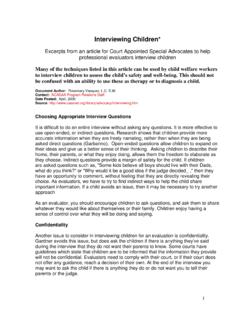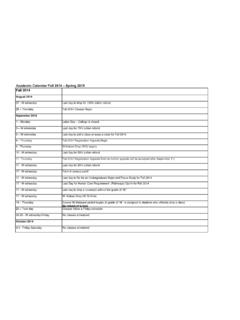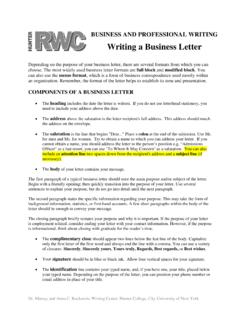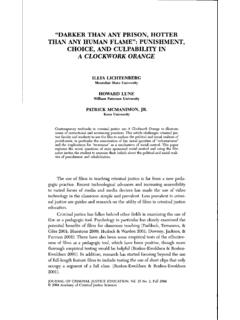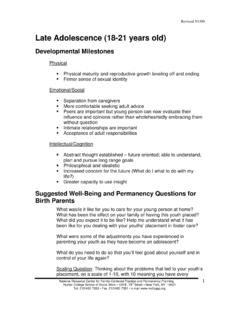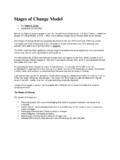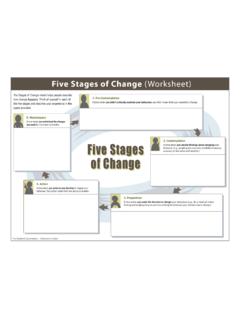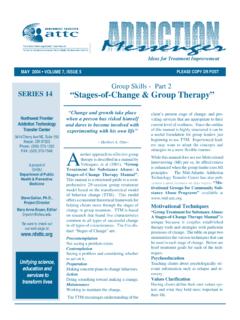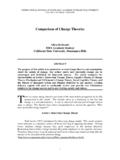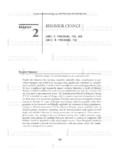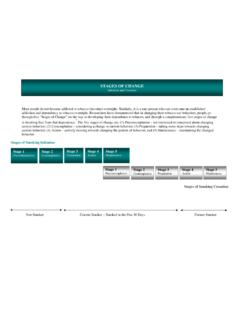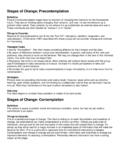Transcription of NRCFCPP Concurrent Permanency Planning Curriculum …
1 A Service of the Children s Bureau ACF/DHHS 1 NRCFCPP Concurrent Permanency Planning Curriculum module 3: Stages of change Notes Understanding the change Process/Cycle of change (Adapted from materials developed by Laura Williams, NRCFCPP Consultant) Session Outline Review/Preview Stages of change Lecture 30 minutes Recognizing stages 15 minutes Objectives This module will teach participants: The characteristics of each stage of change in the Prochaska/DiClemente model of Trans-Theoretical change ; The major techniques or strategies to help clients move to the next phase or stage in the process of change . The importance of full disclosure about what needs to happen for parents to reunify with their children.
2 Time 75 minutes Session Material, Handouts and overheads Materials: Overhead Projector/Screen Wall Posters of the Stages of change (optional) Handouts Cycle of change stage of change Description What Helps People change A Service of the Children s Bureau ACF/DHHS 2 NRCFCPP Concurrent Permanency Planning Curriculum module 3: Stages of change Notes Overheads The change Cycle Stages of change What Helps People change What s My stage Pages Session Framework Introduce this section by making the following points about the Cycle of change . change wheel In 1982 James Prochaska and Carlo DiClemente developed a useful model describing how people change . The model was based on self-help change , but research has shown it to underpin all types of change related to behaviors such as addictions to smoking, eating, using drugs.
3 It s not been found to be applicable to sexual abuse situations. This is a unifying theory of change called the Trans-Theoretical Theory of change which takes into consideration the range of theories about how people change (Freud, Jung, Rogers, etc). It assists us in understanding where our clients may be in the cycle of change and how to engage and work with them depending on the stage they are in. Knowing this helps us to help our clients want to change . Circle of change Overhead Note that it s a circle: There are entry and exit points; change takes many tries. It s normal for people to travel around before reaching a stable change . Smokers went between approximately 3 and 7 times, with an average of 4, before finally quitting for good.
4 (Ask if anyone has had an experience quitting smoking and if there is anyone who would want to share. Trainers share experiences as appropriate.) Each relapse brings you one step closer to recovery. Not to encourage relapse, but to prevent demoralization. There are different stages: trainer names them for the group. People can go through the stages rapidly physicians have been known to take people through these quickly. A Service of the Children s Bureau ACF/DHHS 3 NRCFCPP Concurrent Permanency Planning Curriculum module 3: Stages of change Notes Relapse is a slip not a fall off the wagon. Relapse can be an opportunity for change and growth bringing one closer to recovery, not further away.
5 Stages Also note that people present differently at each stage . This will mean that caseworkers will need to use different techniques or strategies at each stage to engage the family member in making changes in the behaviors that have resulted in the involvement of child welfare services. If you meet resistance you may need to change strategies for communication and engagement. Resistance often results from the wrong interventions at the wrong time. Let s explore this concept of resistance : Most people who are faced with change are not ready to take action (80%). Several stages must be passed through BEFORE action occurs. Object is to move people from one stage to the next, NOT directly to action or maintenance.
6 stage -specific communication skills and strategies are required. As an example put the following on a flip chart and discuss: When people who quit smoking entered a study at different stages the results were different. In a study of how smokers change over time, we learn that the stage clients are in when they engage in change impacts how they move into action and maintenance of change . Of those who entered in the Pre-contemplation phase and moved on to the action phase, only 6% were abstinent after 18 months 15% of those who entered in the Contemplation phase moved on to action and were abstinent after 18 months 24%1 of those who entered in the Determination phase moved on to action and were abstinent after 18 months 1 Changing for Good, James O.
7 Prochaska, John C. Norcross, Carlo C. Diclemente (Avon: New York), 1994 A Service of the Children s Bureau ACF/DHHS 4 NRCFCPP Concurrent Permanency Planning Curriculum module 3: Stages of change Notes Stages of change Using overheads/handouts describing each change stage . Comment that these stages are in the change module of the handout packet. Review each stage and refer to the types of behaviors associated with each stage and the strategies that work to engage clients, not trigger resistance. When we push or use an inappropriate strategy, we may contribute to the person s inability to make change . Include reference to common defense mechanisms (usually seen in Pre-Contemplation that keep people from changing).
8 Discussion Pre-contemplation Description: Who Me? Someone else, other than the person, knows about the problem, person who reported abuse. Often person surprised when subject is brought up Seldom present for treatment unless coerced when they become defensive contemplators Comment that in the Pre-Contemplation stage in particular, we may see a range of defense mechanisms that prevent people from hearing/understanding the need for change . Pre-contemplation is characterized by four varieties of the basic defense mechanisms: Making the least of it: denial and minimization. Denial filters out information. (I don t have a problem.) Minimization makes light of it.
9 (I hardly hit him at all). Another way clients will let us know they are in Pre-Contemplation is Good excuses: rationalization = plausible explanations for behavior that others can easily see are full of holes (I need drugs to relax.) Intellectualization uses abstract analysis to rob events of personal significance (My uncle drank a pint of whiskey a day and lived to be 90). Turning outward: Projection and displacement. Displacement (scape-goating) putting feelings elsewhere (the problem is you took my kid; constant criticizing of wife to avoid hearing her criticism). Projection is diagnosing in another the problems you have. Turning inward: internalization. Swallowing feelings, leading to self-blame, low self-esteem, depression.
10 (I can t do it; I just can t do it; I shouldn t have tried.) A Service of the Children s Bureau ACF/DHHS 5 NRCFCPP Concurrent Permanency Planning Curriculum module 3: Stages of change Notes So what do we do? Strategy Provide information and feedback to raise problem awareness and possibility of change shows them where they are in relation to others Raise doubt to increase the client s perception of risks and problems with current behavior. Help them do a self-assessment. Identify relationships that help rather than enable Create awareness of defenses especially in a therapeutic situation. Prescriptive advice can be counterproductive can only create resistance to change . Contemplation Description Ambivalence: Seesaw of considering and rejecting change Reasons for concern and justifications for lack of concern.
